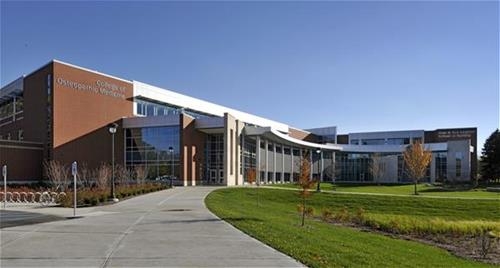You have /5 articles left.
Sign up for a free account or log in.

The Michael A. Evans Center for Health Sciences is likely to keep its name at Marian University, even after the donor it is named for could not fulfill a large portion of a major pledge.
Marian University
It’s hard to watch $38 million melt away.
But that’s effectively what Marian University in Indianapolis has had to do. The small Roman Catholic university on the city’s west side secured a very public $48 million pledge from a wealthy donor at the beginning of the decade as it sought to expand with a new medical school. Then a series of business troubles hit the donor, drastically cutting his wealth and his ability to pay.
Today, Marian says it has received just under $10 million of the pledged donation. It’s budgeting as if no more is coming. Now university leaders are arguing Marian stands as proof institutions can weather the loss of large, high-profile donations if they’ve put the right financial plans in place. The university is operating in the black, they said.
“Any institution that builds a financial plan off of one thing is being reckless,” said Daniel J. Elsener, Marian’s president. “Anything can go wrong. What’s guaranteed in the world?”
The fact remains, however, that the pledge’s evaporation has raised some uncomfortable issues for Marian -- as it would for any university. It’s opened the question of slowing an ambitious construction schedule. It has eaten into endowment growth. Perhaps most visibly, it has left Marian with a medical school building named after a donor who could not fulfill his $48 million pledge.
Marian has been respectful of the donor, Michael Evans, in its response. That reaction is worth examining, fund-raising experts say. It deals with an element that’s more difficult than the financial books -- the human element. And future donors are watching.
Evans was the CEO of locally based toxicology tester AIT Laboratories. He pledged the $48 million gift in 2010. The gift became public in 2011, when Marian was breaking ground on a new building to hold its medical and nursing schools. The university announced at the time it was naming the building the Michael A. Evans Center for Health Sciences.
Since then, however, Evans and AIT have run into financial trouble. Much of Evans’s wealth was in AIT, even after he sold the company to its employees. But the company fell on hard times amid a decline in Medicare reimbursement rates, and it was recently sold to a private equity firm in Texas. Earlier this year, Evans also settled a lawsuit brought by the U.S. Department of Labor alleging that he sold AIT to employees for more than it was worth. He did not admit wrongdoing.
Evans’s lawyer, Andrew McNeil, declined to comment on his client’s finances for the Indianapolis Business Journal but told the publication Evans “just wants to move on.”
Yet there are no plans to remove his name from the medical school building at Marian. Evans ultimately gave about $10 million toward the construction of a $44 million building. The gift was critically important because the money came when Marian was trying to get construction off of the ground, according to Elsener.
“There’s no building without him,” said Elsener, who has been president at Marian since 2001. “I can’t see how we could have done it without him.”
Elsener has also seen no indication that Evans planned to walk back his loan pledge. The parties had done their due diligence, only to have several unlikely events combine to derail the pledge, he said.
“We didn’t do this on the back of a napkin,” Elsener said. “When Mike Evans made this pledge, the world was different. He showed me, he showed us: ‘Here’s our books.’”
No one knows for sure how common it is for major donations to evaporate, said Paul Schervish, professor emeritus and retired director of the Center on Wealth and Philanthropy at Boston College. Such events are usually kept private.
They do leak out from time to time under various circumstances, though. For example, Duke University recently made a claim on Chesapeake Energy Corp. co-founder Aubrey McClendon’s estate, alleging he did not fulfill $10 million in pledges before he died. When such situations do become public, it’s important for institutions to remember they can be a blow to individual reputations, Schervish said.
“I think it’s important to understand the terrible embarrassment and reluctance of the donor to cancel the pledge,” he said. “It’s one thing to drop it because you don’t like what the institution has done with the first part of the pledge. It’s another thing to drop it when you simply can’t afford it.”
Parties will typically do what they can to salvage a pledge, Schervish said. But when there is no way to salvage it, the institution has to pick up the pieces and move forward.
Confidence is key, said Elizabeth Herman, a consultant and former executive in several institutions’ fund-raising departments. An institution will have to project confidence, she said. It will need the confidence of its donors, particularly in a time when there is already widespread hand-wringing about higher education finance, she said.
“What is the story, how is the donor handled, how is the institution perceived?” she said. “That’s so critical, because you can’t go about backstopping unless everyone is quite clear and full of integrity about what happened and why. The story is everything in a situation like this, or it could be catastrophic.”
Any impact on future donations is uncertain. Experts were split about whether a pledge evaporating could help or hurt fund-raising, agreeing it depends on the situation and individuals involved.
Marian is putting forward a confident face, sharing information on its financial situation. The university built contingencies into its financial plan, insulating it from unexpected events, Elsener said. Plus, the $48 million pledge was to come in over eight years, meaning the lost revenue doesn’t hit home all at once. Marian is also able to absorb some financial blows because its other fund-raising is up, as are enrollments. The new medical school has opened and is operating at capacity, adding millions in revenue.
Marian plans about $40 million in new construction in the next 35 to 40 months as it continues to grow enrollment, Elsener said. It’s not clear yet whether the evaporation of Evans’s gift will force Marian to change its construction schedule. At the moment, the university plans on moving forward as scheduled but could slow plans if necessary.
The loss of the gift could also have an impact on Marian’s rate of endowment growth. The endowment has grown since 2001, when it was $2.9 million. Net assets were $67 million in the 2016 fiscal year and are expected to jump to $80 million in 2017. By 2025, Marian wants to be at more than $200 million.
The large gift would have made it easier to grow the endowment, Elsener said. Yet although the endowment is important, it is not driving the college’s core operations, he said.
“If our fund-raising was way up, or enrollment is way up, and the gift comes in, then our endowment is quite bigger,” Elsener said. “We use it almost solely on scholarships.”
Because of the amount already paid and after accounting adjustments for factors like inflation, the loss of Evans’s pledge required Marian to write a $30 million reserve into its books. It’s a lot of money for an institution of Marian’s size, even if it is a number living only in an accounting ledger. But Elsener said successful fund-raising and enrollment growth can help offset the number.
“It’s an anomaly, but you’ve got to plan for anomalies,” he said.
Marian posted a record $24 million in fund-raising in the fiscal year ending June 30. It expects revenue to rise by more than $10 million in 2017, pushing total revenue above $100 million. Total enrollment is projected to grow to more than 3,000 students, up from 2,750.
The medical school, which opened in 2013, is also now up to 600 students. Tuition from the school is a major source of income, roughly $30 million.








